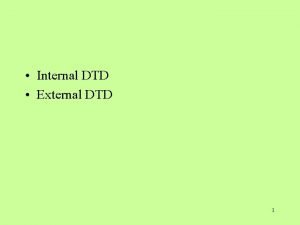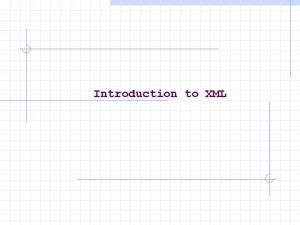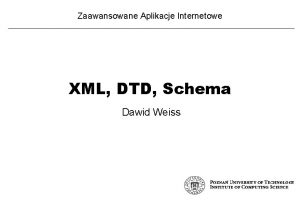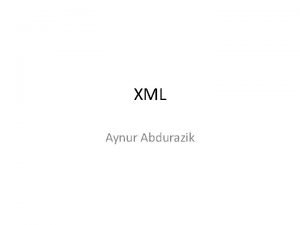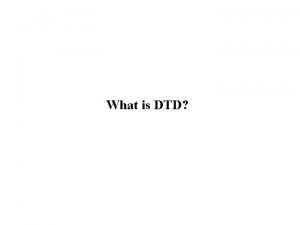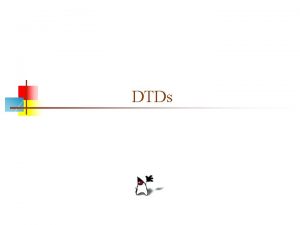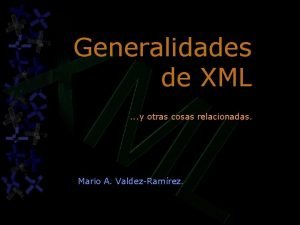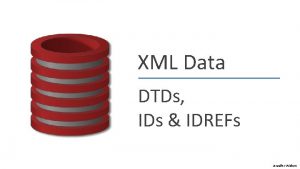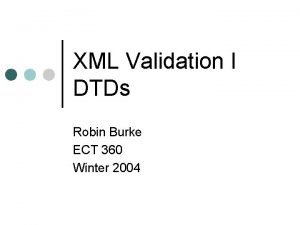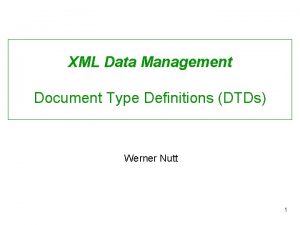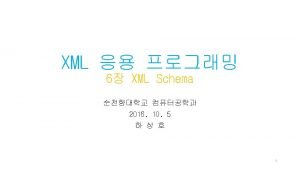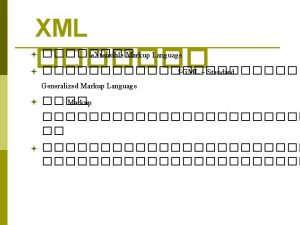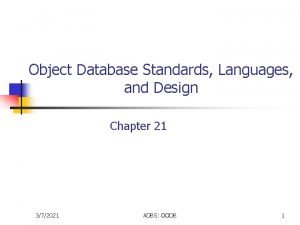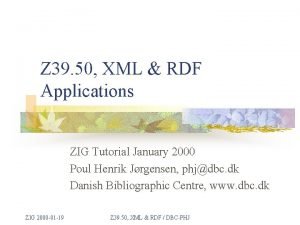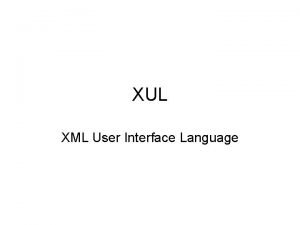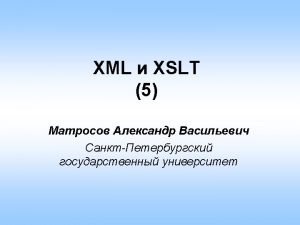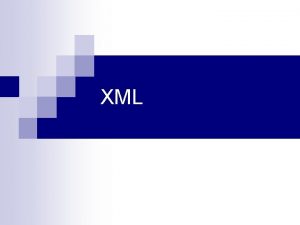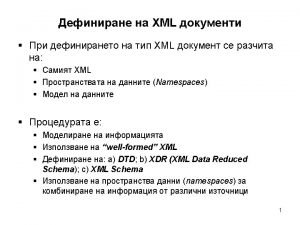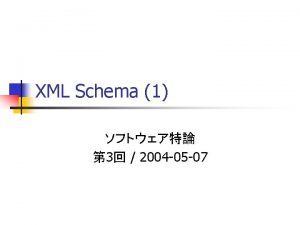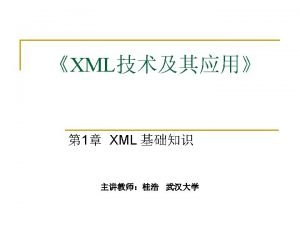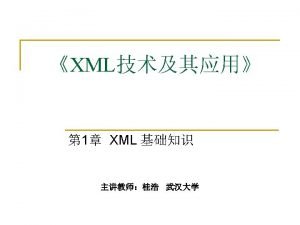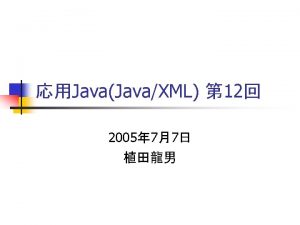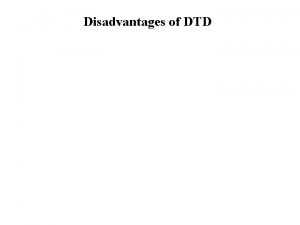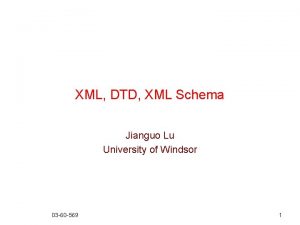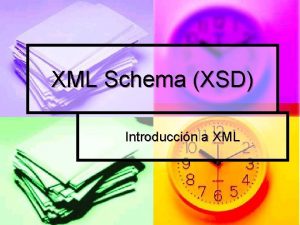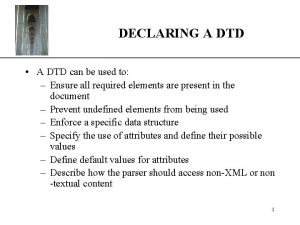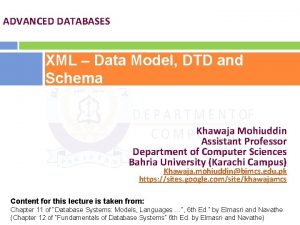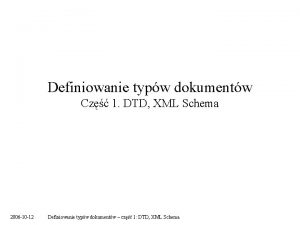PRESENTATION XML Schema XML DTD students student xml







































- Slides: 39

PRESENTATION XML Schema







XML 스키마 개요 DTD와 스키마 예제 비교 <students> student. xml <student> <sno> s 100</sno> <name> 고소영 </name> <age> 26 </age> <phone>02 -123 -8989</phone> <address> 서울 한남동</address> </students> student. dtd <!ELEMENT students (student)*> <!ELEMENT student (sno, name, age, phone, address) > <!ELEMENT sno (#PCDATA)> <!ELEMENT name (#PCDATA)> <!ELEMENT age (#PCDATA)> <!ELEMENT phone (#PCDATA)> <!ELEMENT address (#PCDATA)> <xsd: schema xmlns: xsd="http: //www. w 3. org/2001/XMLSchema"> <xsd: element name="student"> <xsd: complex. Type> <xsd: sequence> <xsd: element name="sno" type="xsd: string"/> <xsd: element name="name" type="xsd: string"/> <xsd: element name="age" type="xsd: string"/> <xsd: element name="phone" type="xsd: string"/> <xsd: element name="address" type="xsd: string"/> </xsd: sequence> </xsd: complex. Type> </xsd: element> </xsd: schema> student. xsd

XML 스키마 개요 • DTD를 XML Schema로 변환 DTD XML 스키마 <!ELEMENT> <element/> <!ATTLIST> <attribute/> , <sequence>. . . </sequence> | <choice>. . . <choice> + min. Occurs ="1" max. Occurs="unbounded" ? min. Occurs ="0" max. Occurs="1" * min. Occurs ="0" max. Occurs="unbounded"








XML 스키마 사용법 • XML 스키마 선언 - XML 스키마의 네임스페이스 속성을 설정하고 사용하기 위해서 선언 - 형식 <xsd: schema xmlns: xsd="http: //www. w 3. org/2001/XMLSchema"> target. Namespace="http: //www. dankook. ac. kr" xmlns="http: //www. mysite. com" element. Form. Default="qualified" attribute. Form. Default="qualified">. . . </xsd: schema> - XML 스키마 선언은 <xsd: schema> 요소로 시작 - 최상위 요소는 항상 schema


XML 스키마 사용법 • 기본 네임스페이스로 XML 스키마 선언 - XML 스키마와 관련된 요소에는 “xsd”라는 접두사를 사용하지 않아도 됨 <schema xmlns="http: //www. w 3. org/2001/XMLSchema" target. Namespace="http: //www. dankook. ac. kr" xmlns: std="http: //www. mysite. com" element. Form. Default="qualified" attribute. Form. Default="qualified">. . . </schema>

XML 스키마 사용법 • 요소 선언과 요소 타입 정의 - 요소 정의 <element abstract = boolean : false block = (#all | List of (extension | restriction | substitution)) default = string final = (#all | List of (extension | restriction)) fixed = string form = (qualified | unqualified) id = ID max. Occurs = (non. Negative. Integer | unbounded) : 1 min. Occurs = non. Negative. Integer : 1 name = NCName nillable = boolean : false ref = QName substitution. Group = QName type = QName {any attributes with non-schema namespace. . . }> Content: (annotation? , ((simple. Type | complex. Type)? , (unique | keyref)*)) </element>


XML 스키마 사용법 • 단순 데이터 타입 - <simple. Type> 요소 사용해서 정의 - XML 스키마에서 정의한 다른 단순 데이터 타입을 이용해서 정의 가능 - 내부에 다른 요소나 속성을 포함할 수는 없음 - restriction, list, union 이용해서 확장 가능 - simple. Type 요소 정의 형식 <simple. Type final = (#all | (list | union | restriction)) id = ID name = NCName {any attributes with non-schema namespace. . . }> Content: (annotation? , (restriction | list | union)) </simple. Type>

XML 스키마 사용법 • 제한 요소 정의와 사용 - 새로운 단순 데이터 타입은 기존의 단순 데이터 타입이 가질 수 있는 값의 범위를 제한해서 정의할 수 있다. - restriction 요소 정의 형식 <restriction base = QName id = ID {any attributes with non-schema namespace. . . }> Content: (annotation? , (simple. Type? , (min. Exclusive min. Inclusive | max. Exclusive | max. Inclusive total. Digits | fraction. Digits | length | min. Length max. Length | enumeration | white. Space | pattern)*)) </restriction> | | |



XML 스키마 사용법 • 복합 데이터 타입 - 요소를 정의하고 사용하기 위해서 기본적으로 복합 데이터 타입 (complex. Type)을 정의해서 사용 - 자식 요소나 속성을 필요로 하는 요소를 정의하기 위해서는 복합 데이터 타입으로 정의 - 형식 <complex. Type abstract = boolean : false block = (#all | List of (extension | restriction)) final = (#all | List of (extension | restriction)) id = ID mixed = boolean : false name = NCName {any attributes with non-schema namespace. . . }> Content: (annotation? , (simple. Content | complex. Content | ((group | all | choice | sequence)? , ((attribute | attribute. Group)*, any. Attribute? )))) </complex. Type>

XML 스키마 사용법 • 순차 요소 정의와 사용 - DTD의 컴마(, ) 연산자에 해당 - 자식 요소들이 순서대로 나타나야 하는 경우 사용 ü <sequence> 요소 : 발생 횟수 표현, “max. Occurs” 와 “min. Occurs” 속성을 가짐 기본값은 1로 사용 - 형식 <sequence id = ID max. Occurs = (non. Negative. Integer | unbounded) : 1 min. Occurs = non. Negative. Integer : 1 {any attributes with non-schema namespace. . . }> Content: (annotation? , (element | group | choice sequence | any)*) </sequence> |

XML 스키마 사용법 • 선택 요소 정의와 사용 - 선택은 여러 개의 자식 요소중에서 선택적으로 요소를 정의하는 것 - 자식 요소의 발생 횟수를 지정하기 위해서 “max. Occurs” 와 “min. Occurs” 속성을 가지고 있음 - 형식 <choice id = ID max. Occurs = (non. Negative. Integer | unbounded) : 1 min. Occurs = non. Negative. Integer : 1 {any attributes with non-schema namespace. . . }> Content: (annotation? , (element | group | choice sequence | any)*) </choice> |



XML 스키마 사용법 • 속성 선언 - 속성은 어떤 자식 정보 항목도 포함할 수 없음 (복합데이터 타입으로 정의할 수 없음) - 속성은 순서가 없음 - 형식 <attribute default = string fixed = string form = (qualified | unqualified) id = ID name = NCName ref = QName type = QName use = (optional | prohibited | required) : optional {any attributes with non-schema namespace. . . }> Content: (annotation? , (simple. Type? )) </attribute>



XML 스키마 사용법 • XML 스키마 주석 형식 <annotation id = ID {any attributes with non-schema namespace. . . }> Content: (appinfo | documentation)* </annotation> <appinfo source = any. URI> Content: ({any})* </appinfo> <documentation source = any. URI xml: lang = language> Content: ({any})* </documentation>





THANKYOU
 Xxxaaabbb
Xxxaaabbb Document object model
Document object model Dtd vs schema
Dtd vs schema Slidetodoc
Slidetodoc Abdurazik
Abdurazik What is dtd?
What is dtd? Dtd in web technology
Dtd in web technology Dtd
Dtd Dtd
Dtd Dtd idrefs
Dtd idrefs Dtl dta
Dtl dta Type:document
Type:document Dtd visual studio
Dtd visual studio Tei dtd
Tei dtd Dtd
Dtd Dtd
Dtd Dtd
Dtd Dtd
Dtd Whats dtd
Whats dtd Dr miguel morayta rizal
Dr miguel morayta rizal Xml schema 예제
Xml schema 예제 Xml schema root element
Xml schema root element Presentation in hindi topic
Presentation in hindi topic Mapping eer to odb schema
Mapping eer to odb schema Your last weekend
Your last weekend We ...... a big piece of wood last saturday. (see)
We ...... a big piece of wood last saturday. (see) National student clearinghouse student tracker
National student clearinghouse student tracker Class maths student student1 class student string name
Class maths student student1 class student string name National student clearinghouse student tracker
National student clearinghouse student tracker Freckle student dashboard
Freckle student dashboard Good morning students,
Good morning students, Sls reset password
Sls reset password Student engagement presentation
Student engagement presentation Mentovertical diameter
Mentovertical diameter Leopold's maneuver
Leopold's maneuver Zig xml
Zig xml What is xul
What is xul Microsoft xml
Microsoft xml Xray xml editor
Xray xml editor Dublin core xml
Dublin core xml
